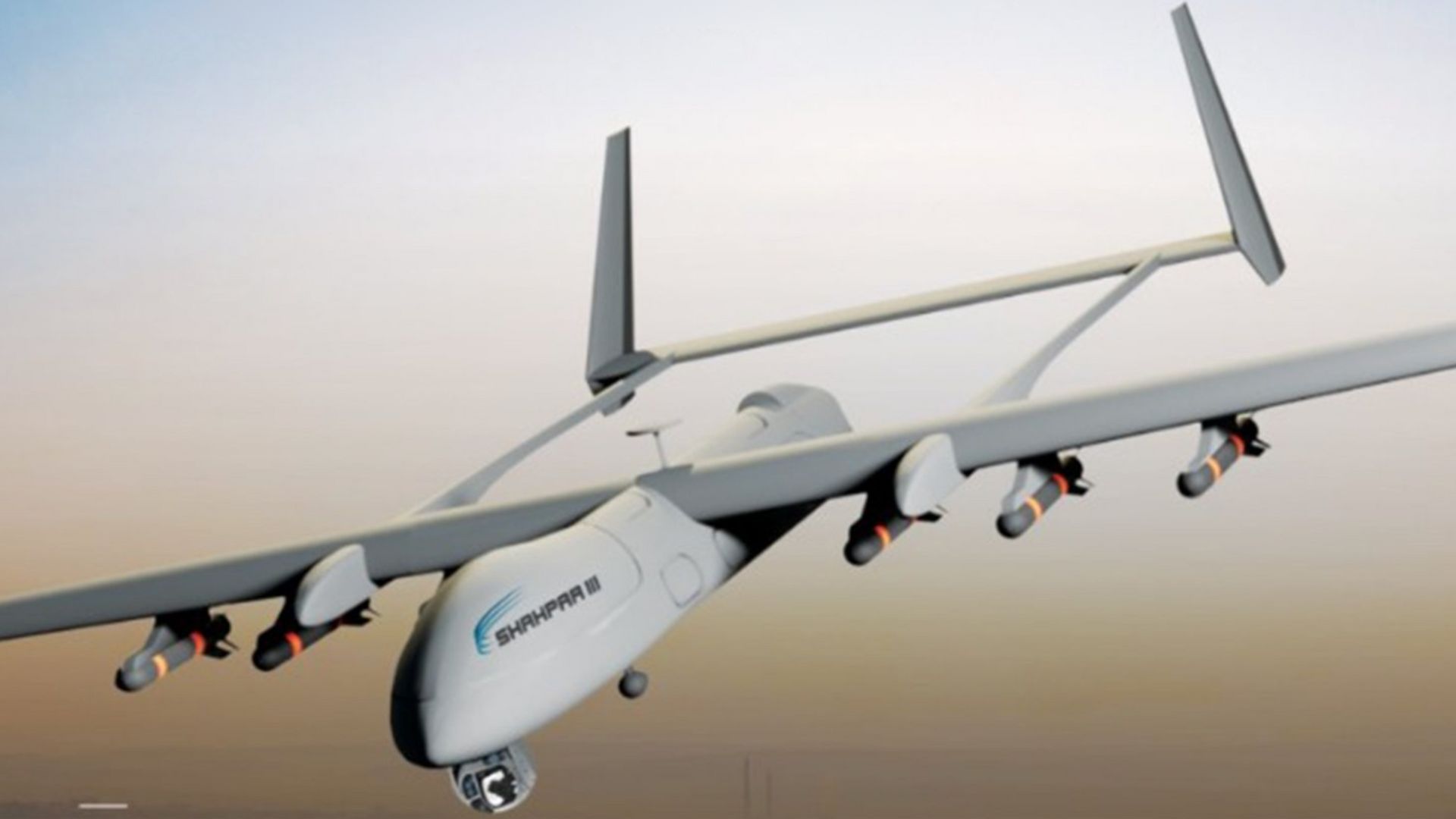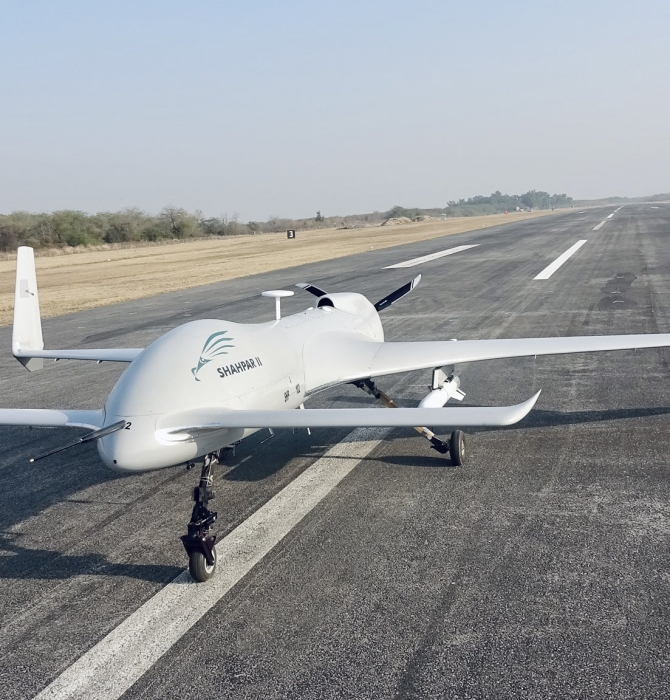8223Views

GIDS Shahpar-3 Unmanned Aerial Vehicle (UAV)
The Shahpar-III/Shahpar-3 is Pakistan’s largest and most advanced homegrown unmanned aerial vehicle (UAV). A Group-4-class drone platform, the Shahpar-III was developed by the National Engineering and Scientific Commission (NESCOM) and marketed and sold by Global Industrial and Defence Solutions (GIDS).
Shahpar-3 Design Background
The Shahpar-III is a substantial step forward over its predecessor, the Shahpar-II Block-II, also developed by NESCOM. Weighing over 600 kg more than the Shahpar-II, the Shahpar-III offers more than double the weapons payload capacity and twice as much endurance.
Using this additional capacity, the Shahpar-III can undertake a greater variety of roles compared to the Shahpar-II, such as maritime missions and stand-off range weapon (SOW) deployment, among others.
GIDS Shahpar-3 Specifications
NESCOM/GIDS offer the Shahpar-III in two engine configurations, one with a 140 HP powerplant, and the other with a 170 HP system.
Both variants offer a payload capacity via six hardpoints. Seeing how GIDS used a range of 400-500 kg to describe the payload, the type of powerplant may have an impact on the final capacity. For example, the 140 HP engine variant may have a capacity closer to 400 kg, while the more powerful 170 HP variant would offer 530 kg.
The Shahpar-III leverages indigenously developed avionics and other electronic subsystems, such as the electro-optical and infrared (EO/IR) turret, electronic support measures (ESM) suite with electronic as well as communications intelligence (ELINT and COMINT), and a synthetic aperture radar (SAR) system.
GIDS states that the Shahpar-III is also equipped with an anti-icing or de-icing system and dual redundant flight control computer using 1553 architecture. The UAV could also leverage a satellite communications (SATCOM) terminal, enabling it to reach a beyond-line-of-sight (BLoS) range of up to 3,000 km.
Physical Dimensions
- Maximum Take-Off Weight (MTOW): 1,650 kg
- Length: TBC
- Wingspan 64 ft
Performance Parameters
- Range (BLoS): 3,000 km
- Service Ceiling
- Unarmed: 30,000 ft
- Armed: 28,000 ft
- Endurance
- 140 HP
- Unarmed: 24 hours
- Armed: 17 hours
- 170 HP
- Unarmed: 40 hours
- Armed: 20 hours
- 140 HP
- Payload:
- Internal: 165 kg
- External: 400-530 kg across six hardpoints
Overall, GIDS is steering the Shahpar-III as an alternative to other 1,500-2,000-kg MALE UAVs, such as the Chinese Wing Loong-II, Turkish Aerospace Industries (TAI) Anka-S, and the U.S. MQ-1C. The stated specifications are broadly comparable, but as the Shahpar-III has yet to be introduced into service, actual performance parameters are as of yet to be determined.
Key Capabilities of the Shahpar-3
Elevated Strike Capabilities
While the GIDS Shahpar-2 Block-II introduced a genuine drone-based strike capability through lightweight air-to-ground missiles (AGM), the Shahpar-III promises to be a more impactful strike system.
During the 2024 International Defence Exhibition and Seminar (IDEAS 2024), GIDS showcased a variety of stand-off range weapons (SOW) alongside the Shahpar-III, such as the Rasoob 250 air-launched cruise missile (ALCM) and the Qaswa Industries AZB-81LR ‘smart diameter bomb’ (SDB).
The ability to carry SOWs like ALCMs and SDBs enables the Shahpar-III to pose a credible threat against high-value targets (HVT) in conventional conflict scenarios. While a slow-moving aircraft, the Shahpar-III could launch the Rasoob 250 ALCM up to 350 km away from the target, i.e., a safe distance from enemy anti-air warfare (AAW) threats. Thus, the Shahpar-III – alongside the Pakistan Air Force’s (PAF) Bayraktar Akıncı high-altitude long-endurance (HALE) UAV – could form the foundation of future unmanned combat aerial vehicle (UCAV) doctrines by fielding the initial use of SOWs from drone platforms.
ISTAR and ELINT
At IDEAS 2024, GIDS also showcased several sensor solutions for use from the Shahpar-III. In addition to the Zumr-II EO/IR turret, GIDS also revealed the development of a synthetic aperture radar (SAR) as well as an airborne version of the Ribat ESM suite, the latter offering ELINT and COMINT capabilities.
These systems would enable the Shahpar-III to play a larger role as an ISTAR (intelligence, surveillance, reconnaissance, and target acquisition) asset. Pakistan, for example, could use the Shahpar-III’s longer endurance (24~40 hours) to set up a pervasive airborne ELINT presence so as to monitor for and record radio frequency signals. This would greatly free up crewed platforms from the role and, potentially, allow Pakistan to extend its ELINT coverage by a significant margin.
Maritime Role
GIDS also revealed an ‘ultra-lightweight’ anti-submarine warfare (ASW) torpedo called the ‘Eghraaq’ at IDEAS 2024. One of the value propositions of the Eghraaq is that it can be integrated onto drones, giving them an ASW capability.
To help build the Shahpar-III’s ASW capability, Pakistan is also developing a dual-active and passive sonobuoy.
Alongside the Rasoob 250 ALCM (which is also capable of striking ships) and homegrown SAR, the Shahpar-III can also be positioned as a maritime solution.
Comprehensive Support Package
Finally, like the Shahpar-II, GIDS also offers a complete suite of weapons, sensors, data-link, and mission planning system alongside the Shahpar-III. Every key solution can be single-sourced from Pakistan and, effectively, through GIDS as the sole contractor.
News Updates, Comments, and Analysis
News: GIDS Reveals Cruise Missile Lineup for Shahpar-III Drone (November 2024)
Global Industrial and Defence Solutions (GIDS) revealed the Rasoob 250 and AZB-81LR air-launched cruise missiles (ALCM) for use from the NESCOM Shahpar-III medium-altitude long-endurance (MALE) drone. Read the full article here.
Analysis: New Air-Launched Munitions Are a Key Piece of Pakistan's Drone Program (May 2024)
The development of the Burq-series air-to-ground missiles (AGM) and KaGeM V3 miniature air-launched cruise missiles (ALCM) are major pieces of Pakistan’s emerging drone strategy. Read the full article here.


